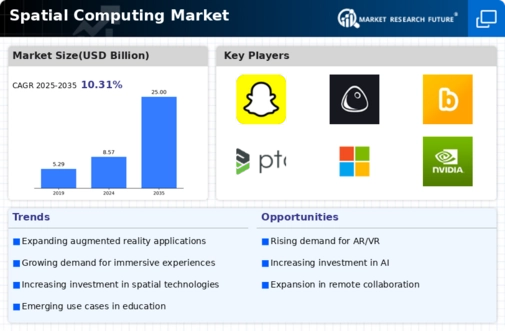Market Share
Spatial Computing Market Share Analysis
The Spatial Computing Market is a thriving, fast-dynamic sector that is targeted at creating tech that connects physical and virtual realms. In order to have an edge over the others and to extend their market share, companies in this industry rely on various positioning techniques.
The innovation, as well as the technological advancement, one of the efficient strategies in the Spatial Computing Market. Organizations are trying to create spatial computing solutions that leave the user with a sense of novelty and cutting-edge technology. Adopting AR, VR, or MR technologies can help companies position themselves as disruptors in their industries. This is an important strategic move that targets customers with a strong disposition towards immersive and interactive experiences which in turn increases market share.
Another key strategy is tailor-made for each industry. Companies in the Spatial Computing industry have a range of solutions that align with different industries or applications. Whether it's playing games, doing health care, designing buildings or doing manufacturing, companies provide tailored Spatial computing resources that meet the specific needs and challenges of each industry. Companies can draw potential customers and consequently get a larger market share by providing customized solutions.
Furthermore, Spatial Computing companies work towards ease of use and accessibility. They will design the spatial computing system which would be simple and easy for users with the possibility to interact with the digital content in the spatial environment. By bringing a smooth and simple interaction, companies will gain the customers who prio" This approach also enables companies to provide solutions that are affordable for low- and high-level technology users alike and to break into different markets thus increasing their market share.
Also, companies in Spatial Computing Market are striving for integration and interoperability. They focus on making that their spatial computing solutions can be seamlessly integrated into what already exists in the market. With compatibility to playing devices, software, or data structure, companies can make the integration process effortless for customers. This approach enables businesses to enter developed markets at a quicker pace and achieve higher market share as they offer solutions that fit well with the prevailing infrastructure.
Partnerships as well as collaborations further helps the companies of the Spatial computing market grow their market share. They build strategic partnerships with the technology providers and the industry leaders or content creators to offer customers a one-stop shopping experience that deals with their various problems. Through the partnerships with established players in the industry companies can access unexplored markets, gain a bigger customer pool and get an advantage in the competition.


















Leave a Comment